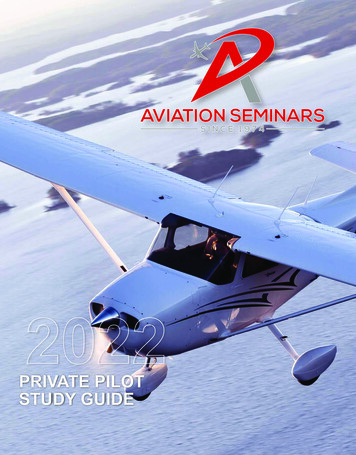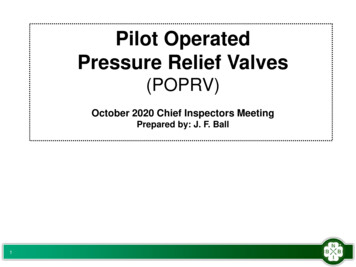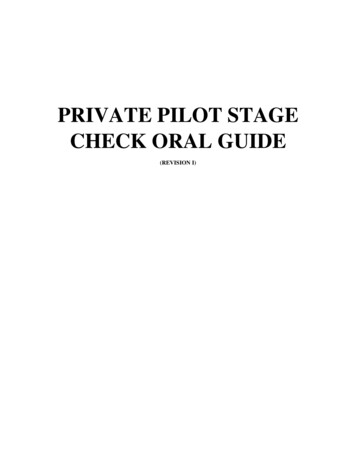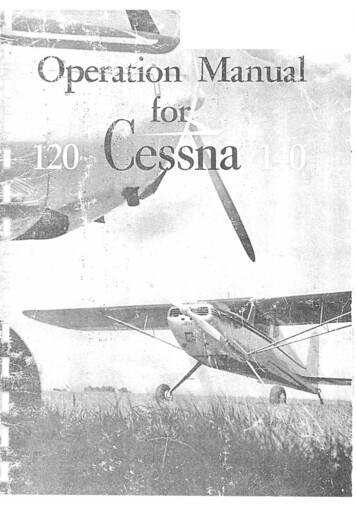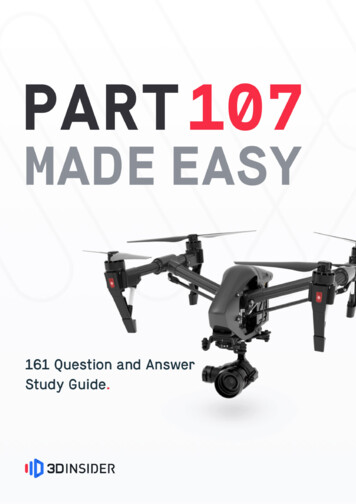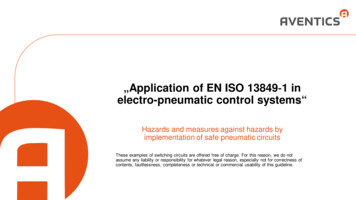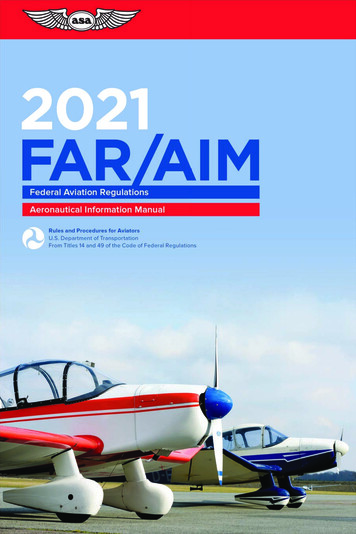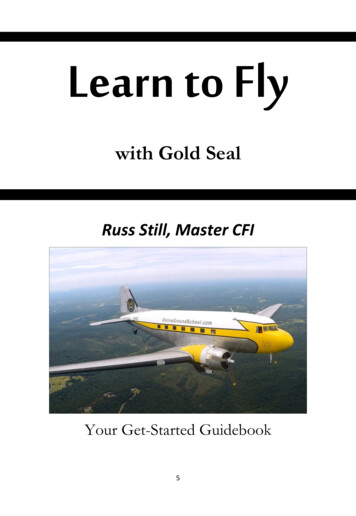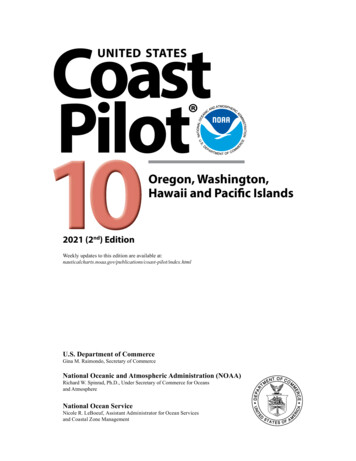
Transcription
CoastPilotUNITED STATES Oregon, Washington,Hawaii and Pacific Islands2021 (2nd) EditionWeekly updates to this edition are available t/index.htmlU.S. Department of CommerceGina M. Raimondo, Secretary of CommerceNational Oceanic and Atmospheric Administration (NOAA)Richard W. Spinrad, Ph.D., Under Secretary of Commerce for Oceansand AtmosphereNational Ocean ServiceNicole R. LeBoeuf, Assistant Administrator for Ocean Servicesand Coastal Zone Management
IIU.S. Coast Pilot 1001 MAY 2022 Vancouver CANADAUNITED STATES FRA N KLI N D .R OOSE VE LT L A KESeattle TakomaGrays HarborWASHINGTON ERC O LU M B I A R I VNORTH PACIFICOCEANPortland &RDVW 3LORW &KDSWHU ,QGH[&KDSWHU &KHWFR 5LYHU WR &ROXPELD 5LYHU 2UHJRQ &KDSWHU &ROXPELD 5LYHU 2UHJRQ DQG :DVKLQJWRQ&KDSWHU &ROXPELD 5LYHU WR 6WUDLW RI -XDQ 'H )XFD :DVKLQJWRQ&KDSWHU 6WUDLW RI -XDQ 'H )XFD DQG *HRUJLD :DVKLQJWRQ&KDSWHU 3XJHW 6RXQG :DVKLQJWRQ&KDSWHU DZDLL&KDSWHU 3DFLILF ,VODQGVCape BlancoO r e G O N CALIFORNIA HAWAI‘IAN ISLANDS Asuncion I. Agrihan I.KauaiPagan I.OahuMARIANA ISLANDSMaui (Farallon de Pajeros Anatahan I.HawaiiSaipan I. RotaGuam Tinian I.
01 MAY 2022 PrefacePrefaceThe United States Coast Pilot is published by the National Ocean Service (NOS), National Oceanic and AtmosphericAdministration (NOAA), pursuant to the Act of 6 August 1947 (33 U.S.C. 883a and b), and the Act of 22 October1968 (44 U.S.C. 1310).The Coast Pilot supplements the navigational information shown on NOAA nautical charts. The publication is continuallyupdated and maintained from inspections conducted by NOAA survey vessels and field parties, corrections publishedin Notices to Mariners, information from other Federal agencies, State and local governments, maritime and pilots’associations, port authorities, and concerned mariners.NOAA’s Office of Coast Survey encourages public feedback regarding its suite of nautical charting products and servicesthrough ASSIST, Coast Survey’s stakeholder engagement and feedback tool. This allows customers to submit questions orcomments or to report an error with NOAA’s nautical charts and products.Customers can access ASSIST at t/Those who prefer to communicate by telephone can contact Coast Survey at 1–888–990–6622.Coast Pilot corrections are no longer published in the NGA Notice to Mariners effective 01 January 2021. Additionalinformation regarding the NGA policy change can be referenced at msi.nga.mil/NTM in the Notice to Mariners 52/20Hydrogram and Marine Information sections.Coast Pilot UpdatesCheck for weekly critical updates for this edition at ndex.html(See 33 CFR 164.33 Charts and Publications, chapter 2, for regulations.)Customers may print the specifically affected paragraphs to revise this book, or download an updated file (PDF) ofthe entire volume.A Weekly Record of Updates is provided directly preceding the index.III
IV U.S. Coast Pilot 1001 MAY 2022
01 MAY 2022 ContentsContentsPreface IIIChapter 1: General Information 1Chapter 2: Navigation Regulations 33Chapter 3: Oregon and Washington 191Chapter 4: Chetco River to Columbia River, Oregon 203Chapter 5: Columbia River, Oregon and Washington 227Chapter 6: Columbia River to Strait of Juan De Fuca, Washington 257Chapter 7: Strait of Juan De Fuca and Georgia, Washington 275Chapter 8: Puget Sound, Washington 309Chapter 9: Hawaii 349Chapter 10: Pacific Islands 421Navigation Rules 441Appendix A 467Weekly Record of Updates 473Index 477V
VIContents01 MAY 2022
01 MAY 2022 U.S. Coast Pilot 10, Chapter 1 General Information(1)UNITED STATES COAST PILOT (2)The United States Coast Pilot, published by theNational Oceanic and Atmospheric Administration(NOAA), is a series of ten nautical books (volumes) thatencompasses a wide variety of information important tonavigators of U.S. coastal/intracoastal waters and thewaters of the Great Lakes. The Coast Pilot is intended tobe used as a supplement to NOAA nautical charts. Muchof the content cannot be shown graphically on the chartsand is not readily available elsewhere. Topics which arecovered include environmental factors of weather, climate,ice conditions, tides, water levels, currents, prominentcoastal features and landmarks. Specific informationon vertical clearances, wharf descriptions, small-craftfacilities, hazards, dredged channels and depths are alsoprovided. Navigation services and regulations are alsoidentified including pilotage, towing, anchorages, routesand traffic separation schemes, environmental protection,and other Federal laws.(3)New editions of each volume are issued annually.Fully updated files are posted weekly on the Internet, andare also available through NOAA Certified Chart Agentsat www.nauticalcharts.noaa.gov.(4) Amendments to this publication are available /index.html.sequence, north to south on the east coast, east to west onthe gulf coast, clockwise around each of the Great Lakesand south to north on the west coast and Alaskan coast.Features are described as they appear on the largest scalechart, with that chart number prominently shown in blue.(10)Appendix A contains contact information regardingthe various products, services and agencies detailedthroughout the volume.(11)Navigation Rules— preceding Appendix A,contains the International (72 COLREGS) and InlandNavigation Rules, technical Annexes, and associatedFederal rules and regulations.(12)The Weekly Record of Updates is intended as a logfor critical updates applied to this volume.(13)The Index contains geographic names mentionedthroughout a Coast Pilot volume. These names areboldfaced and indexed along with the number of thelargest scale chart on which the entire feature appears.Asterisks preceding a chart number in the index ofCoast Pilot 5 indicate charts published by the NationalGeospatial-Intelligence Agency, and in the index of CoastPilot 6, charts published by the Canadian HydrographicService.(14)BearingsBearings and courses are in degrees true and aremeasured clockwise from 000 (north) to 359 . Thebearings of an aid to navigation (e.g., directional light,light sector, range) are given as viewed from the bridgeof a vessel toward the light.(15)(5)Using the Coast PilotChapter 1 contains definitions of general andstandard terms used throughout the volume, discussionsof NOAA charting products and services, descriptions ofmaritime services by various U.S. Government agencies,Notices to Mariners and other information pertinent tosafe navigation.(7) Chapter 2 contains selected extracts from the Codeof Federal Regulations (CFR) that affect mariners.(8) Chapter 3 contains general information that ispeculiar to the region covered by a particular Coast Pilotvolume. For example, practical information regardingoffshore currents and dangers, coastal aids to navigation,prominent landmarks and the general character of thecoast and depths helpful in approaching the region.(9)In Chapter 4 and the remaining numberedchapters, the detailed description of the region begins.A map precedes each chapter and outlines the nauticalcharts used in the area to be discussed. In these chapters, asmuch as possible, the coastal description is in geographic(6)(16)Bridges and CablesVertical clearances of bridges and overhead cablesare in feet above mean high water unless otherwise stated;clearances in Coast Pilot 6 are in feet above Low WaterDatum unless otherwise stated. When the water levelis above Low Water Datum, the bridge and overheadcable clearances given in the Coast Pilot and shown onthe charts should be reduced accordingly. Clearancesof drawbridges are for the closed position, although theopen clearances are also given for vertical-lift bridges.Whenever a bridge span over a channel does not open fullyto an unlimited clearance position, a minimum clearancefor the sections over the channel is given; the same appliesto swing and pontoon bridges with openings less than 50feet horizontally. Clearances given in the Coast Pilot arethose approved for nautical charting and are supplied bythe U.S. Coast Guard (bridges) and U.S. Army Corps ofEngineers (cables). See charts for horizontal clearances(17) 1
2 U.S. Coast Pilot 10, Chapter 1 of bridges, as these are generally given in the Coast Pilotonly when they are less than 50 feet (15 meters). Tableslisting structures across waterways, found in some CoastPilots, show both horizontal and vertical clearances.Submarine cables are rarely mentioned.(18)Cable ferriesCable ferries are guided by cables fastened toshore and sometimes propelled by a cable rig attachedto the shore. Generally, the cables are suspended duringcrossings and dropped to the bottom when the ferries dock.Where specific operating procedures are known they arementioned in the text. Since operating procedures vary,mariners are advised to exercise extreme caution andseek local knowledge. DO NOT ATTEMPT TO PASSA MOVING CABLE FERRY.(19)(20)CoursesThese are true and are given in degrees clockwisefrom 000 (north) to 359 . The courses given are thecourses to be made good.(21)(22)CurrentsStated current velocities are the averages at strength.Velocities are in knots, which are nautical miles per hour.Directions are the true directions to which the currents set(see chapter 3, this book).(23)(24)DepthsDepth is the vertical distance from the chart datumto the bottom and is expressed in the same units (feet,meters or fathoms) as those soundings found on the chart.(See Chart Datum, this chapter, for further detail.) Thecontrolling depth is the least known depth of a channel.This depth is determined by periodic hydrographicsurveys and restricts use of the channel to drafts lessthan that depth. The centerline controlling depth appliesonly to the channel centerline or close proximity; lesserdepths may exist in the remainder of the channel. Themidchannel controlling depth is the controlling depthof only the middle half of the channel. Federal projectdepth is the original design dredging depth of a channelplanned by the U.S. Army Corps of Engineers (USACE)and may be deeper than current conditions. For this reason,project depth must not be confused with controlling depth.Depths alongside wharves usually have been reported byowners and/or operators of the waterfront facilities andhave not been verified by Government surveys. Sincethese depths may be subject to change, local authoritiesshould be consulted for the latest controlling depths.(26)For all maintained channels with controlling depthsdetailed on charts in tabular form, the Coast Pilot usuallystates only the project depths. For all other channels whichmay be depicted on charts with depth legends, notes orsoundings, the Coast Pilot will list where to find the mostrecent information on the latest known surveys. Depthsmay vary considerably between maintenance dredging.(25)01 MAY 2022(27)Under-keel clearancesIt is becoming increasingly evident that economicpressures are causing mariners to navigate through watersof barely adequate depth, with under-keel clearancesbeing finely assessed from the charted depths, predictedtide levels and depths recorded by echo sounders.(29)It cannot be too strongly emphasized that evencharts based on modern surveys may not show all seabed obstructions or the shoalest depths, and actual tidelevels may be appreciably lower than those predicted.(30)In many ships an appreciable correction must beapplied to shoal soundings recorded by echo soundersdue to the horizontal distance between the transducers.This separation correction, which is the amount by whichrecorded depths therefore exceed true depths, increaseswith decreasing depths to a maximum equal to half thedistance apart of the transducers; at this maximum thetransducers are aground. Ships whose transducers aremore than 6 feet (1.8 meters) apart should constructa table of true and recorded depths using the TraverseTables. (Refer to the topic on echo soundings elsewherein chapter 1.)(31)Other appreciable corrections, which must beapplied to many ships, are for settlement and squat. Thesecorrections depend on the depth of water below the keel,the hull form and the speed of the ship.(32)Settlement causes the water level around the shipto be lower than would otherwise be the case. It willalways cause echo soundings to be less than they wouldotherwise be. Settlement is appreciable when the depth isless than seven times the draft of the ship and increasesas the depth decreases and the speed increases.(33)Squat denotes a change in trim of a ship underway,relative to her trim when stopped. It usually causes thestern of a vessel to sit deeper in the water. However, it isreported that in the case of mammoth ships, squat causesthe bow to sit deeper. Depending on the location of theecho sounding transducers, this may cause the recordeddepth to be greater or less than it ought to be. Cautionand common sense are continuing requirements forsafe navigation.(28)(34)DistancesThese are in nautical miles unless otherwise stated. Anautical mile is one minute of latitude, or approximately2,000 yards, and is about 1.15 statute miles.(36)Coast Pilot 6 is in statute miles unless otherwisestated. A statute mile is 5,280 feet or about 0.87 nauticalmile.(35)(37)Geographic CoordinatesGeographic coordinates listed in the Coast Pilot arereferred to North American Datum of 1983 (NAD 83)unless otherwise noted for certain CFR extracts in chapter2.(38)
01 MAY 2022 U.S. Coast Pilot 10, Chapter 1 are used. Unless otherwise indicated, speeds are given inknots, which are nautical miles per hour.Heights(40)These are in feet (meters) above the tidal datum (58)used for that purpose on the charts, usually mean highNAUTICAL CHARTSwater. However, the heights of the decks of piers andwharves are given in feet (meters) above the chart datum(59)NOAA produces and maintains a suite of over 1,000for depths.nautical charts that cover the U.S. coastal waters, the(41)Coast Pilot 6 is in feet (meters) above the chartGreat Lakes and U.S. territories. These charts providedatum used for that purpose on the charts, usually Lowa graphic representation of water depths, the shoreline,Water Datum.prominent topographic and man-made features, aids to(42)navigation and other navigational information useful toLight and Sound Signal Characteristicsthe mariner. NOAA’s charts are available in a variety of(43)These are not described in the Coast Pilot. Also,digital formats designed to meet the specific requirementslight sectors and visible ranges are generally not fullyof all mariners. Paper copies may also be obtained throughdescribed. This information can be found in U.S. Coastone of NOAA’s Print-on-Demand partners.Guard Light Lists.(60)(39)Paper Print on Demand Nautical ChartsThe content of Print-On-Demand (POD) charts isupdated weekly by NOAA with the most current U.S.Coast Guard Local Notice to Mariners and other criticalsafety information. POD charts are printed under theauthority of NOAA and shipped through partnershipsbetween NOAA and commercial providers. PODinformation and a list of participating POD chart agentscan be found at s and other obstructions are mentioned only ifthey are relatively permanent and in or near normal trafficroutes.(61)(46)Radio Navigational AidsFor detailed information on Radio Navigation Aidssee the United States Coast Guard Light Lists andthe National Geospatial-Intelligence Agency’s RadioNavigational Aids, Publication 117.(47)(48)Ranges(49)These are not fully described. “A 339 Range”means that the rear structure bears 339 from the frontstructure. (See United States Coast Guard Light Lists.)(50)Reported informationInformation received by NOAA from varioussources concerning depths, dangers, currents, facilities,and other topics, which has not been verified byGovernment surveys or inspections, is often included inthe Coast Pilot; such unverified information is qualifiedas “reported” and should be regarded with caution.(51)(52)TidesTidal information, including real-time water levels,tide predictions and tidal current predictions are availableat tidesandcurrents.noaa.gov.(53)(54)TimeUnless otherwise stated, all times are given in localstandard time in the 24-hour system. (Noon is 1200, 2:00p.m. is 1400 and midnight is 0000.)(55)(56)WindsDirections are the true directions from which thewinds blow; however, sometimes (rarely) compass points(57)(62)Portable Document Format (PDF) Nautical ChartsAlmost all of NOAA’s nautical charts may bedownloaded for free as Portable Document Format(PDF) files at tml#full-size-nautical-charts. The PDFnautical charts are exact replicas of the images used toproduce POD and Raster Navigational Charts (RNC).As such, they also have all the latest updates based onU.S. Coast Guard Local Notices to Mariners, NationalGeospatial-Intelligence Agency Notices to Mariners andother critical safety information.(64)Most PDF charts can be printed at the proper scalefrom any plotter accommodating a 36-inch paper width.When printed properly, PDF charts and POD charts arevery similar, but PDF charts have not yet been approvedto meet Federal regulations for paper chart carriagerequirements as POD charts have.(63)(65)BookletChartsThe NOAA BookletChart is a product that canbe printed by the users for free. They are made to helprecreational boaters locate themselves on the water.BookletCharts are reduced in scale and divided into pagesfor convenience but otherwise contain all the informationof the full-scale nautical charts and are updated weekly.For more information visit html#booklet-charts.(66) 3
4 U.S. Coast Pilot 10, Chapter 1 (67)Raster Navigational Charts (NOAA RNC )(68)NOAA Raster Navigational Charts (NOAA RNC )are geo-referenced digital images of NOAA’s entire suiteof paper charts. NOAA RNCs are official data that canbe used in many types of electronic charting systems(ECS), including Raster Chart Display Systems (RCDS)and some Electronic Chart Display and InformationSystems (ECDIS). Current regulations support the useof RNCs as a primary means of navigation when ENCsare not available, but they require an accompanyingminimal set of up-to-date paper charts. They can integrateposition information from the Global Positioning System(GPS) and other navigational sensors, such as radar andautomatic identification systems (AIS) to show a vessel'strack, waypoints, and planned routes. NOAA RNCsand their weekly updates are available free of chargeat html.(69)Electronic Navigational Charts (NOAA ENC )NOAA Electronic Navigational Charts (NOAAENC ) are databases of charted objects and their attributeswith standardized content, structure and format. Theycomply with International Hydrographic Organization(IHO) specifications stated in IHO Publication S-57. Theymay be used as an alternative to paper charts required onSOLAS class vessels.(71)ENCs are intended for use in electronic chartingsystems (ECS) as well as Electronic Chart Display andInformation Systems (ECDIS). ECDIS are programmableto show as much or as little data as the user requires.They can integrate position information from the GlobalPositioning System (GPS) and other navigational sensors,such as radar and automatic identification systems (AIS)to show a vessel's track, waypoints and planned routes.Using this information ECDIS can use ENCs to givewarning of impending danger in relation to the vessel'sposition and movement. NOAA ENCs and their updatesare available free of charge at 72)Nautical Chart—New Editions and CorrectionsNew editions of paper Print-on-Demand (POD)charts are available on the Monday after NOAA clears anew edition for release. Once the authorized POD chartis available, it meets federal chart carriage requirements,and should be put into service immediately. It should beupdated from the last correction and cleared throughdates shown in the lower left corner of the chart.(74)The chart date is of vital importance to the navigator.When charted information becomes obsolete, furtheruse of the chart for navigation is dangerous. Natural andartificial changes, many of them critical, are occurringconstantly; therefore it is important that navigators useup-to-date charts. Nautical charts and publications are(73)01 MAY 2022available for purchase from authorized POD agents andtheir sales outlets.(75)NOAA’s “Nautical Chart Update” website allowsmariners to update their nautical charts from one databasethat includes information from NOAA, NGA U.S. Noticeto Mariners, U.S. Coast Guard Local Notices to Marinersand the Canadian Coast Guard Notices to Mariners ml.(76)Nautical Chart Numbering SystemThis chart numbering system, adopted by NOAAand National Geospatial-Intelligence Agency (NGA),provides for a uniform method of identifying chartspublished by both agencies. Nautical charts publishedby NGA and by the Canadian Hydrographic Service areidentified in the Coast Pilot by an asterisk preceding thechart number.(77)(78)Chart ScaleThe scale of a chart is the ratio of a given distanceon the chart to the actual distance that it represents onthe earth. For example, one unit of measurement on a1:10,000 scale chart is equal to 10,000 of the same uniton the earth's surface. Large scale charts show greaterdetail of a relatively small area. Small scale charts showless detail but cover a larger area. Certain hydrographicinformation may be omitted on smaller scale charts.Mariners should always obtain the largest scalecoverage for near shore navigation.(80)The scales of nautical charts range from 1:2,500 toabout 1:5,000,000. Graphic scales are generally shownon charts with scales of 1:80,000 or larger, and numericalscales are given on smaller scale charts. NOAA charts areclassified according to scale as follows:(81)Sailing charts, scales 1:600,000 and smaller, arefor use in fixing the mariner’s position approachingthe coast from the open ocean or for sailing betweendistant coastwise ports. On such charts the shoreline andtopography are generalized and only offshore soundings,principal lights, outer buoys and landmarks visible atconsiderable distances are shown.(82)General charts, scales 1:150,000 to 1:600,000, arefor coastwise navigation outside of outlying reefs andshoals.(83)Coast charts, scales 1:50,000 to 1:150,000, arefor inshore navigation leading to bays and harbors ofconsiderable width and for navigating large inlandwaterways.(84)Harbor charts, scales larger than 1:50,000, are forharbors, anchorage areas and the smaller waterways.(85)Special charts, at various scales, cover theIntracoastal waterway and miscellaneous small-craftareas.(79)(86)Chart ProjectionsThe Mercator projection used on most nauticalcharts has straight-line meridians and parallels that(87)
01 MAY 2022 intersect at right angles. On any particular chart thedistances between meridians are equal throughout, butdistances between parallels increase progressively fromthe equator toward the poles so that a straight line betweenany two points is a rhumb line. This unique property ofthe Mercator projection is one of the main reasons whyit is preferred by the mariner.(88)The Polyconic projection is used on most U.S.nautical charts of the Great Lakes. On this projection,parallels of latitude appear as non-concentric circles, andmeridians appear as curved lines converging toward thepole and concave to the central meridian. The scale iscorrect along any parallel and along the central meridianof the projection. Along other meridians the scaleincreases with increased difference of longitude fromthe central meridian.(89)Chart Datum, Tidal WatersChart Datum is the particular tidal level to whichsoundings and depth curves on a nautical chart orbathymetric map are referred. The tidal datum of MeanLower Low Water is used on all NOAA charts, except forcharts in the Great Lakes and non-tidal inland waterways.For information on Chart Datum, Great Lakes System,see Coast Pilot 6, chapter 3.(90)(91)Horizontal DatumNautical charts are constructed based on one of anumber of horizontal datums which are adopted to bestrepresent individual regions around the world. Note thatthe terms horizontal datum, horizontal geodetic datum,and horizontal control datum are synonymous.(93)The exact placement of lines of latitude and longitudeon a nautical chart is dependent on the referencedhorizontal datum. Charts of the United States are currentlyreferenced primarily to the North American Datum of1983 (NAD 83), and the World Geodetic System 1984(WGS 84). WGS 84 is equivalent to the NAD 83 forcharting purposes.(94)NAD 83 and WGS 84 have replaced the NorthAmerican Datum of 1927 and other regional datums asthe primary horizontal datum to which NOAA charts arereferenced. Since some geographic positions may still bereferenced to the older datums, NOAA has included noteson charts which show the amount to shift those positionsin latitude and longitude to fit the chart’s NAD 83 or WGS84 projection.(95)It should be noted that the physical shift betweenpositions on older datums and NAD 83/WGS 84 wassignificant. Mariners should always be certain thepositions they are plotting on a nautical chart are on thesame datum as the chart.(92)(96)Chart AccuracyThe value of a nautical chart depends upon theaccuracy of the surveys on which it is based. The chart(97)U.S. Coast Pilot 10, Chapter 1 reflects what was found by field surveys and what has beenreported to NOAA. It also represents general conditionsat the time of surveys or reports and does not necessarilyportray present conditions. Significant changes may havetaken place since the date of the last survey or report.(98)Each sounding represents an actual measure of depthand location at the time the survey was made, and eachbottom characteristic represents a sampling of the surfacelayer of the sea bottom at the time of the sampling. Areaswhere sand and mud prevail, especially the entrances andapproaches to bays and rivers exposed to strong tidalcurrent and heavy seas, are subject to continual change.(99)In coral regions and where rocks and bouldersabound, it is always possible that surveys may havefailed to find every obstruction. Thus, when navigatingsuch waters, customary routes and channels should befollowed, and areas where irregular and sudden changesin depth indicate conditions associated with pinnaclerocks, coral heads, or boulders should be avoided.(100)Information charted as “reported” should be treatedwith caution when navigating the area, because the actualconditions have not been verified by government surveys.(101)Source Diagrams and Zone of Confidence DiagramsThe age and accuracy of hydrographic survey datathat support nautical charts can vary. Depth informationon nautical charts, paper or digital, is based on data fromthe latest available hydrographic survey, which in manycases may be quite old. Diagrams are provided on nauticalcharts to assist mariners in assessing hydrographicsurvey data and the associated level of risk to navigatein a particular area. There are currently two types ofdiagrams shown on NOAA paper and raster navigationalcharts (RNCs) of 1:500,000 scale and larger—Zone ofConfidence (ZOC) Diagrams and Source Diagrams.ZOC information (designated CATZOC) is also foundon electronic navigational charts (ENCs). This providesconsistency in the display of source data between ENCsand newer paper charts.(103)Both types of diagr
23 JAN 2022 1U.S. Coast Pilot 10, Chapter 1 General Information (1) UNITED STATES COAST PILOT (2) The United States Coast Pilot, published by the National Oceanic and Atmospheric Administration (NOAA), is a series of ten nautical books (volumes) th
